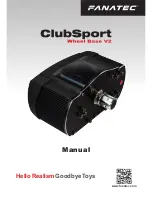
Chapter 3 Radio Installation
Figure 3-2 DSP to Radio Cable Connections for Radio Ports 1 and 2
If you’ll be using a Packet channel that’s shared with voice users, then you should connect the black wire to the
Squelch status pin of the connector. This will prevent the DSP from transmitting when there’s a received signal
strong enough to open the squelch. If you connect this pin, you may have to change the setting of the
SQUELCH
command in the DSP. (Most VHF/UHF Packet operations are no longer shared with voice users so this connection
generally isn’t needed.)
As an example for determining the Radio cable connection to a radio, let’s say you want to hook up an Alinco DR-
112 to your DSP. Go to
Appendix A
and turn to the page listing the Alinco radios. There, the DR-112 is listed and to
its right—under the
Figure
column—it refers you to
Figure 2
and the
Notes
column,
Note 1
. Turn to the first page
of the Appendix and read
Note 1
. It doesn’t really apply because if we look at
Fig. 2
on the next page, it shows that
the green wire in the Radio cable, Receive Audio, is hooked up to pin 6 in the Alinco’s mike connector. The brown
wire, Ground, is connected to pin 7; the braided cable shield, to pin 8; the white wire, Mike Audio (AFSK) to pin 1,
and finally the red wire, PTT, to pin 2.
So, to fashion the radio cable:
1. Locate one of the 5 ft. DSP radio cables included with your DSP.
Note:
that the Radio cables may have been shipped as a single 10 ft. cable which should be cut to
length before use.
2. Prepare the bare end of one of the radio cables by removing an appropriate amount of jacket for the mike
connector you’ll attach. Typically, this is .5 - .75 inches (13 - 19mm).
3. Carefully remove the foil shield exposing the colored wires underneath.
Be careful not to nick or cut the
shield wire
.
4. Strip back about .125 inch (7mm) of colored insulation from the green, red, white and brown wires. (Don’t
strip back the black wire if you don’t intend to use it—just cut it short)
5. Feed the connector’s backshell over the cable end, then look at the connector closely (with a magnifying
glass, if necessary) to locate pin 1. Compare this to the location of pin 1 on the connector drawing in your
transceiver’s manual and also in
Appendix A
. This is important as some diagrams show the connector from
the inside of the transceiver, not the outside of the plug you are wiring. (This will help insure that the plug
is not wired backwards.)
6. Warm up your soldering iron and begin wiring.
Note
: when wiring a connector, it’s often easier to wire the inside or middle pins first then work
your way to the outside pins.
7. Connect the Shield (silver) wire to the mike’s ground connection if your transceiver has one. If it doesn’t
have a separate mike or ground connection, then connect it to the single ground along with the Brown wire.
(See the next step.)
September, 05
3-3
Summary of Contents for DSP-232
Page 120: ...Chapter 6 GPS Applications September 05 6 1...
Page 138: ...Chapter 7 Maildrop Operation 7 18 September 05...
Page 158: ......
Page 159: ...Chapter 8 ASCII and Baudot Operation September 05 8 1...
Page 185: ......
Page 186: ...Chapter 9 AMTOR Operation September 05 9 1...
Page 198: ......
Page 199: ...Chapter 10 Morse Operation September 05 10 1...
Page 207: ......
Page 208: ...Chapter 11 SIAM and NAVTEX Operation September 05 11 1...
Page 230: ......
Page 231: ...Chapter 12 PACTOR Operation September 05 12 1...
Page 240: ...Chapter 13 Troubleshooting September 05 13 9...
Page 254: ...Chapter 13 Troubleshooting 13 9...
Page 256: ...DSP 232 Manual Addendum September 05 AD 2...
Page 259: ...Appendix A Radio Connections Radio Connection Diagrams September 05 A 3...
Page 260: ...Appendix A Radio Connections A 4 September 05...
Page 261: ...Appendix A Radio Connections September 05 A 5...
Page 262: ...Appendix A Radio Connections A 6 September 05...
Page 263: ...Appendix A Radio Connections September 05 A 7...
Page 267: ...Appendix D Mailbox Upgrade September 05 D 2...
Page 268: ...Appendix E Schematics and Pictorial September 05 E 3...
















































